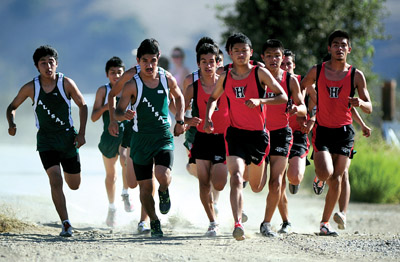A good trail map holds a lot of information for backcountry
travelers, and the one for Henry Coe State Park is the best I’ve
seen.
The first feature you will notice is shaded relief which looks
like the landscape viewed from an airplane with a low sun casting a
shadow across the wrinkled terrain. You see a third dimension on a
two dimensional surface.
A good trail map holds a lot of information for backcountry travelers, and the one for Henry Coe State Park is the best I’ve seen.
The first feature you will notice is shaded relief which looks like the landscape viewed from an airplane with a low sun casting a shadow across the wrinkled terrain. You see a third dimension on a two dimensional surface. Contour lines refine the topographic story. Each line traces a particular elevation; close together they denote steeps slopes, while far apart means easy going for a walker. The Coe map also shows the mileage between key trail junctions, so you can easily calculate the distance of your route.
All of this information is important, especially when you want to leave the trail and travel cross country.
You will find Mike Meyer’s fresh boot tracks on nearly any trail in Coe Park. An avid hiker and good friend, Meyer called me with an invitation to join him on an ambitious and interesting cross-country trek. Good company, fresh terrain … I’m in.
Pine Ridge is the first of a trio of parallel ridges that reach to the northeast. The next ridge over is Middle Ridge followed by Blue Ridge, each of which carries a fork of Coyote Creek in the creases between them.
One Saturday morning, Meyer and I left Coe headquarters bound for the Middle Fork of Coyote Creek between Middle and Blue Ridges. There’s no trail to the Middle Fork or along it. It would be a new adventure for us both.
We set out down the Corral Trail that intersects a hub of trail junctions a half mile away. Here we hopped on the Fish Trail, which took us down to the Little Fork of Coyote Creek, then up to the top of Middle Ridge. That’s where our off trail adventure began.
We walked straight across the top of Middle Ridge as though the Fish Trail continued on the same course. We zigged and zagged down the far side, always seeking the clearer path and easier going. As the contour lines on our map showed, the gradient steepened the closer we got to the Middle Fork. We thrashed and slid down hot, dusty terrain until suddenly we were alone in a lush verdant garden watered by a vigorous branch of Coyote Creek.
There is a special feeling when you leave the trail and visit a secret hidden place. Solitude is everywhere in Coe Park, but by this creekside, a good distance and tough terrain away from any trail, we enjoyed a special magic.
After lunch, we followed the Middle Fork downstream toward Poverty Flat 2 1/2 miles away. On the ridgetops above it was warm and dry, but we were in an oasis, crisscrossing our way down a cool clear creek enjoying every twist and turn along its cobbled bed.
The forest cover opens at Poverty Flat where the Little Fork, which we crossed on the Fish Trail, joins the Middle Fork before heading off to China Hole. I have always wanted to find the guy who built the Poverty Flat Road, our route home, and (assuming he is smaller that I) punch him in the nose. But, in fairness, we were a thousand feet below headquarters, and there’s no easy way home.
Fair warning: Off-trail hiking — this trip as well — can be tough going. If you take this trip or travel off trail in the Coast Range, pick up a pair of short summer gaiters to minimize the number of burrs your socks accumulate. Watch out for poison oak. And take a good map.










